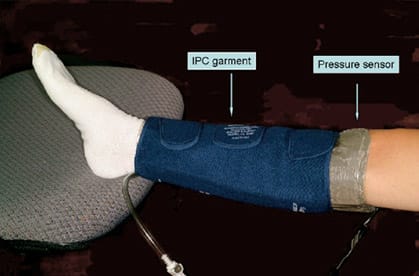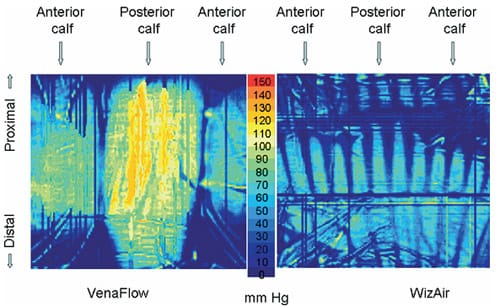Pressure Mapping is a technique that is used to investigate the relationships between the interface pressure produced by Intermittent Pneumatic Compression (IPC) devices, sometimes measured using a pressure mapping film, the deformation of extremity tissues produced by this pressure, and the changes in venous blood flow associated with this deformation. IPC is one of the most frequently used mechanical measures to prevent venous thromboembolisms, which is an important clinical issue. (Additional application glossary information on profiling and mapping can be found under Body Mapping, Contact Pressure Mapping often analyzed using pressure mapping film Surface Force Mapping, Surface Profiling, and Surface Stress Profiling.)
In an attempt to improve the clinical effectiveness of IPC, Fedor Lurie, MD, PhD, Victoria Scott, BSc, Hyo-Chun Yoon, MD, PhD, and Robert L. Kistner, MD, studied the topic and reported their results in a paper presented at the Twentieth Annual Meeting of the American Venous Forum in Charleston, SC, Feb 20-23, 2008. The title of the paper is, “On the Mechanism of Action of Pneumatic Compression Devices: Combined Magnetic Resonance Imaging and Duplex Ultrasound Investigation”.
Two IPC devices with calf garments were selected for this study: the VenaFlow (Aircast Inc, Summit, NJ) and the WizAir (Medical Compression Systems Inc, Ltd, Or Akiva, Israel). Pressure Mapping was accomplished using the Tactilus® Human Body Interface sensor system (Sensor Products Inc, Madison, NJ). Tactilus® is a matrix-based, tactile surface piezoresistive sensor system with a pressure range of 0 to 100 psi. The flexible sensing element used for Pressure Mapping is 32 cm × 32 cm × 0.7-mm-thick. It contains 1,024 sensing points, spaced 2 mm apart. The system records 100 readings per second and performs Pressure Mapping between any two contacting surfaces. It then assimilates the collected data into a Windows®-based tool kit.
Figure 1 is a picture of an IPC garment and the Tactilus® Pressure Mapping sensor on a person’s calf. Figure 2 shows representative Pressure Mapping results on the VenaFlow and the WizAir.
 Pressure Mapping Film Fig 1: The Tactilus® Pressure Mapping Sensor Sits under the IPC Garment. |  Pressure Mapping Film Fig 2: Pressure Mapping Results from the VenaFlow and WizAir IPC Devices |


